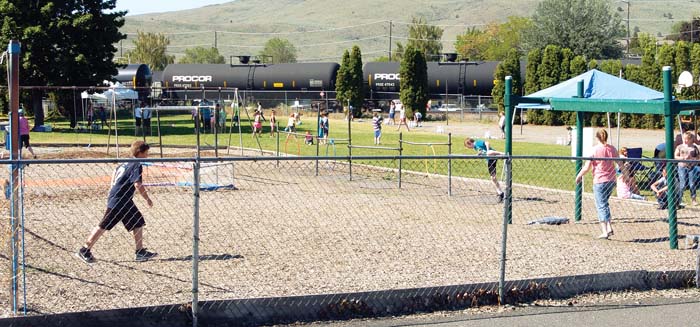A Nearby Threat
Published 7:30 am Thursday, June 9, 2016

- S. John Collins / Baker City HeraldSouth Baker Intermediate students participated in various games and challenges Tuesday as trains roll past the playground. Today is the last day of classes for Baker City schools.
Friday’s derailment of a Union Pacific train carrying crude oil near Mosier caught the attention of emergency officials elsewhere along the railroad’s routes, including Baker City.
Local officials say they’ve gone through training that helps them assess such an incident and organize a response.
Gary Timm, fire services manager for Baker County Emergency Management, said that in addition to regular hazmat (hazardous materials) training, Baker County fire agencies have had extensive training with Union Pacific crews over the years.
“We’ve trained with them and continue to train with them and maintain a good working relationship with them to ensure an effective response to a hazmat incident,” Timm said.
An incident like the one at Mosier — 16 of 96 oil cars derailed and four caught fire — is not as likely locally because oil trains don’t travel through Baker and Union counties as often as they do in the Columbia Gorge, he said.
Most oil trains come from North Dakota and travel through Montana and Washington before joining the Union Pacific tracks in the Columbia Basin.
Timm said oil trains (a train that carries only oil rather than a variety of cargo) traveling through Baker County are rare. If they do travel here, Union Pacific is required to notify the county, he said.
Besides Union Pacific hazmat crews, there are state hazmat teams made up of trained personnel from local agencies who are available to respond and assist with hazmat accidents on local highways, Timm said.
He said fire agencies in the county have participated in training scenarios involving different hazardous materials that are carried by train, including anhydrous ammonia and chlorine.
Several years ago Baker County fire agencies participated in a training event in which Union Pacific provided a tanker car. Timm said it was a realistic scenario, complete with billowing black smoke.
He hopes to organize a similar hazmat training with Union Pacific this year. Timm said it is crucial for all fire agencies in the county but especially the ones whose coverage areas include residential areas near the railroad — Baker City, Haines, North Powder and Huntington fire departments — to participate in the such exercises.
Jason Yencopal, Baker County’s emergency services manager, said the response would depend on the type of hazardous material involved. He said the county and Baker City have an emergency operation plan in place that dictates how a response is organized.
“We rely on Baker City Fire Department or other responding fire agency to make the initial assessment,” Yencopal said. “Depending on the severity of the incident, evacuations may be called for.”
He said the emergency plan explains how that response plays out. The initial assessment by first responders -— law enforcement or fire personnel — dictate what steps are taken regarding how evacuations are conducted and how the public is to be notified.
In some cases it might be safer for residents to stay in their homes and use tape or other materials to seal their homes to keep poisonous gas from entering.
See more in the June 8, 2016, issue of the Baker City Herald.









